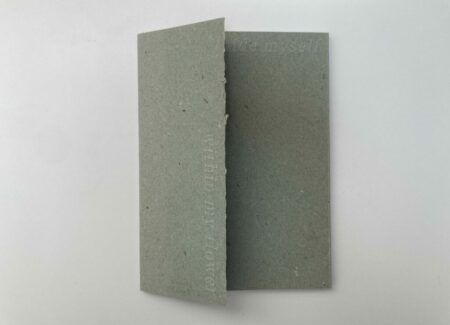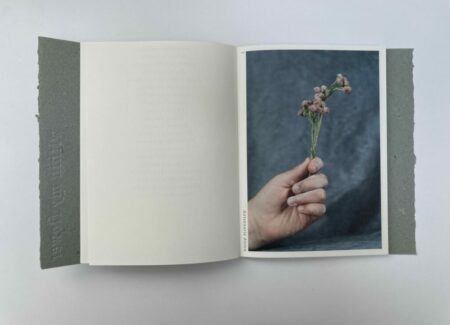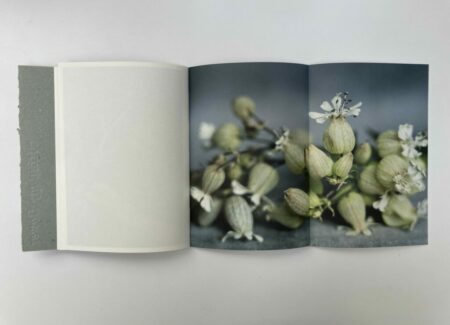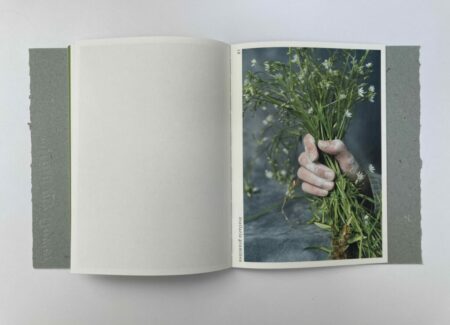JTF (just the facts): Published in 2023 by Multipress (here). Softcover (17 x 23.5 cm), 70 pages, with 20 color photographs. Includes an essay (in multiple parts) by the artist. Design by Kaja Krakowian and Petri Henriksson at Blank Blank. In an edition of 300 copies, each numbered and signed. (Cover and spread shots below.)
Comments/Context: The Norwegian artist Mariken Kramer’s work focuses on “structural and social aspects of the human condition, investigating how we perceive, interact, categorize and tell our stories.” Her earlier photobook The Eyes That Fix You In a Formulated Phrase was shortlisted for the 2018 Paris Photo Aperture Photobook Award and used slides taken by her father in the 1970s as a reflection of her own life and memory. In her new photobook I hide myself within my flower, she brings together photographs of flowers picked around her family mountain farm (located near the lake Møsvatn) and her own expressive writings and reminiscences. Together, they share a larger story of the artist’s mother, including the final months of her life and the vigil at her deathbed.
The book was published by Multipress, an Oslo-based non-profit publisher with an emphasis on photography and a collaborative approach to the book making process. The title of the book is borrowed from the first stanza of an 1859 poem with the same title by Emily Dickinson. The book is hosted inside the cover with overlapping flaps, and is constructed with handmade paper made with the flowers depicted in the book (as well as crushed pebbles from creeks and riverbanks, bits of birch bark and reindeer skin, all from the farm). The title of the book, not immediately visible since it isn’t inked, is embossed on the cover, and the book itself has an open spine and feels delicate and special. All of the photographs are placed on the right side of the spreads, and a couple of fold outs add movement to the overall visual flow. The text is printed on colored paper, with Norwegian on brown and English on a rich grass green. The overall design and references resemble those used in botanical books and herbariums.
The photobook begins with a simple page that contains the title in Norwegian, placed at the very top, with the artist’s name at the bottom. This is followed by a list of all the flowers included in the book. The first photograph shows a hand holding a plant shot against a bluish, slightly blurred, background. This is antennaria dioica, or mountain everlasting, a flower most often found in the mountainous parts of Europe. Other flowers are photographed in a similar way, and usually are held by a family member, creating an intimate feeling of connection to the family farm. Kramer’s writing appears closer to the end of the book and connects back to each flower; just like photographs, each paragraph is numbered and bears the name of the plants depicted.
In another image, a weathered working hand with a bandage holds a bouquet of white cottongrass flowers, a fluffy mass of cotton-like fibers. In her associated text, Kramer recalls the day the doctor told her family that her mother was not going to survive. “A fear that now mixes with my realization that you are actually going to die. My sobs are furry cotton grass, clogging my throat.”
A couple of pages later, a child holds red clover flowers against a blue background of her or his sweater. This shot visualizes memories from Kramer’s childhood. “You taught me how to pluck the small flowers of the red clover and suck on them. Sweet nectar that bumblebees love, on our tongues.”
The book is a record of Kramer’s own grieving process after the loss of her mother. The book ends with a fold out photograph of antennaria dioica once again, this time placed on a rumpled surface, making a full circle with the initial image, like an accepting moment of peace and quiet. “Like the porcelain wrapped in newspaper in the attic. Cold, hard and smooth. Your forehead. I rest mine against yours and I am prepared, I am prepared that you are not here anymore.”
I hide myself within my flower brings to mind the photobook Un montón de ropa (reviewed here) by the Argentinian photographer Lujan Agusti, who used her mother’s clothes to reflect on their relationship and to consider her own memories. Both books share a universal and timeless conversation about family and relationships, and the cathartic power of photography in dealing with loss, memories, and family stories.
The physicality of this book, in its choices of paper stock, color, and smell, comes together in a sensuously tactile experience. As a photobook, I hide myself within my flower is beautifully produced and elegantly designed. Kramer deals with a very personal and sensitive moment in her life, turning to photography to restore a lost sense of balance. And while the book is rooted in pain and loss, it is also full of love and life. There is a sense of meditative optimism found in the ongoing cycle of flowers, and the natural regeneration of life.
Collector’s POV: Mariken Kramer does not appear to have consistent gallery representation at this time. As a result, interested collectors should likely follow up directly with the artist via her website (linked in the sidebar).
















